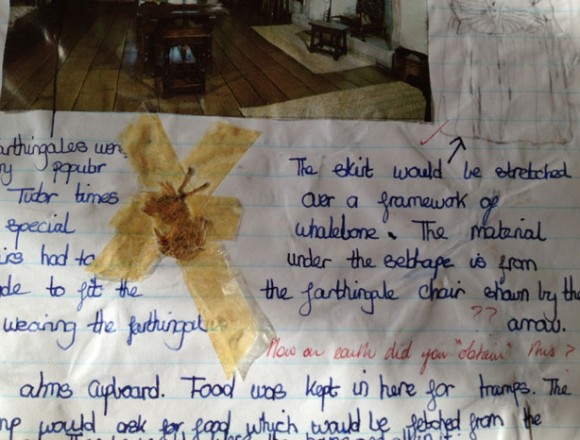I’ve always had a passion for museums, galleries and heritage sites: My earliest ‘wow’ moment was at Shakespeare’s Birthplace, aged 11. My history teacher asked me to find an interesting item from the playwright’s house to illustrate my coursework.
She was rather concerned when I came back with the tiny piece of material shown above. It was hanging tantalisingly by a thread from the cushion on which Shakespeare had rested his famous posterior. Intrigued by the ‘real thing,’ I still experience that excitement when interacting with museum objects today.
I’m lucky that my career combines my combined passions of teaching and museums. I’m a qualified primary school teacher who enjoys stimulating people of all ages in museum and gallery settings. I find it gratifying to enable visitors to find a hook, just like the thread that grabbed me years ago, to engage, inspire and trigger curiosity.
I enjoy seeing visitors, some of whom may not yet know why museums are special, experiencing the same spark and wonder I feel when engaging with the ‘real thing’ – even if it’s a tiny piece of antique thread!
The Shakespeare’s thread incident reminded me of the recent Telegraph debate about whether children should be banned from museums.
Triggered by a photograph of a child clambering on a $10 million dollar sculpture at Tate Modern, I wondered whether this child was curious, intrigued and in awe of the “real thing” as I was around the same age? Like me, perhaps he was also unaware of the potential damaging affects that his actions might have on the object.
Some may argue, that the set of niches displayed in a public space look rather enticing as a climbing wall. Unless explicitly stated, we shouldn’t assume that as museum visitors we are permitted to interact? Do museums project mixed messages about whether we can or cannot touch?
I started to consider some positive ways in which we might convey the message “don’t touch” to visitors. Young curators aged 7-11 years old recently made a film entitled How to visit the Wallace Collection
One child explains:
“We have objects made out of metal; there is armour made out of steel and sculptures made out of bronze. If we touch these spectacular objects then they can be damaged. For example they could rust and that would be really sad.”
Another child describes how acid on our skin reacts and causes damage and advises
“You can look but you can’t touch.”
In some museums, children write their own “don’t touch” labels adding a positive spin, explaining the damage that can be done if we intervene. Some museums have material or wallpaper samples that clearly demonstrate damage from touching over time. Others offer workshops, trails or tours to find out the negative effects of touching sensitive materials and better understand the consequences.

Please Touch! Author image used with permission of
People’s History Museum, Manchester
If we ask children to solve a problem such as how to positively communicate the “don’t touch” message, they often suggest inspiring ideas. Contrary to the opinion that children may damage our Titians or wreak havoc with our ceramic collections, they may better inform and educate visitors on why we shouldn’t touch certain objects.

A young member of Ancient House Museum’s History Club explains why visitors should wear protective gloves to handle objects
During Kids in Museums Takeover Day children takeover museums, galleries and heritage sites. From curators to cafe staff, they are in charge. Children explain to visitors why they cannot touch certain objects on display and explain the reasons for this. Last year, over 6,500 children and young people participated in this initiative. Takeover Day demonstrates that contrary to the idea that children should be banned from museums, they should be welcomed. After all, they are our visitors of the future. If children enjoy museums from an early age and are involved in meaningful decision making, they contribute in great ways to improving the museum’s offer through innovative events and interpretation.
If we ask young people to act as consultants, such as active participants on youth panels, they may find the creative solutions which prevent visitors from removing pieces of antique thread or climbing on intriguing sculptures, even if it’s because we’re in awe of the “real thing!”











